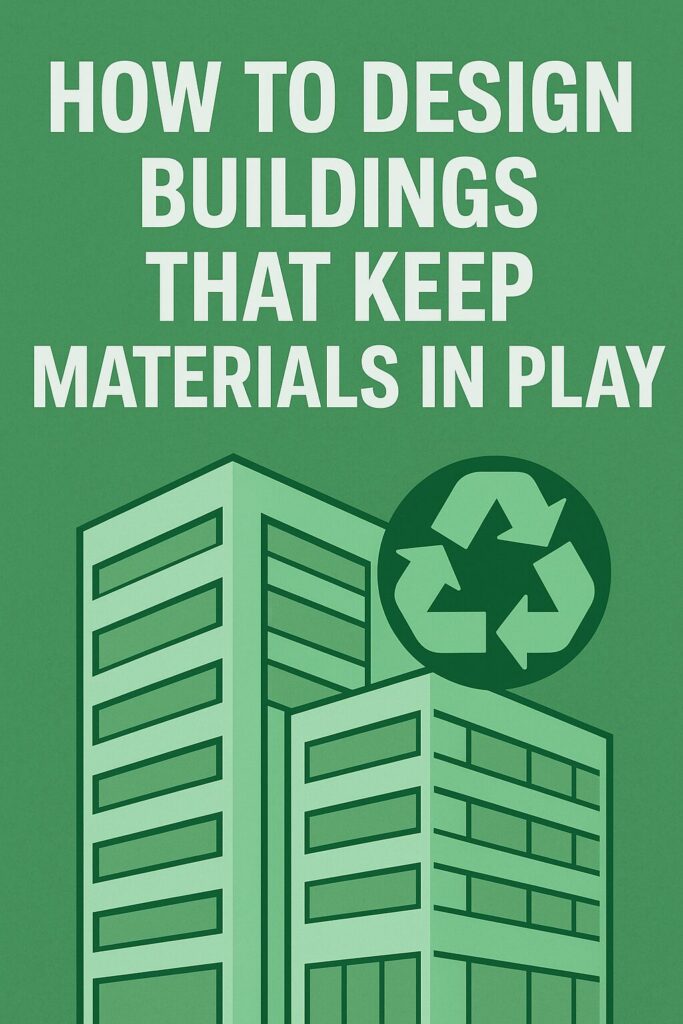Most buildings end up being demolished, stripped, and replaced. Forward-thinking designers are challenging this approach, asking: What if every building could serve as a materials bank?
The future of construction lies in keeping materials in use for longer and recovering their value at the end of each cycle. This principle, the essence of the circular economy, is already reshaping how progressive clients, architects, and manufacturers design and deliver projects.

Build It Once. Use It Again
A circular building is not about recycling at the end. It begins with designing for reuse from the very start.
Imagine steel frames bolted instead of welded, ready to be dismantled and redeployed. Companies such as Cleveland Steel & Tubes are already reclaiming entire structures for reuse. Or consider modular partitions from Clestra Hauserman, which are dry-fixed and demountable. An office one year can become a laboratory the next. This is not flexibility for its own sake, but value retained through design.
Buildings that can adapt hold their worth. Those that cannot, simply become waste.
Specify Materials with a Memory
Circularity thrives on traceability. When you know what a building contains, you can recover it, reuse it, and rebuild with confidence.
This is where Material Passports come in. These digital records document each component’s composition, source, and recyclability. When integrated with BIM (read about it here), they allow future owners and contractors to see exactly what lies behind walls, floors, and ceilings.
Initiatives such as Madaster and Buildings as Material Banks demonstrate that traceability preserves value.
Materials with a memory remain assets. Those without, vanish into landfill.
Choose Materials That Keep on Giving
Not all materials perform equally in a circular world. Some degrade over time, while others can be renewed or endlessly recycled.
- Steel and Aluminium: Infinitely recyclable with no loss of strength (e.g. Tata Steel Infinity, Hydro CIRCAL)
- Timber: Renewable, reclaimable, and repairable (e.g. FSC Glulam and CLT)
- Glass: Remeltable indefinitely (Saint-Gobain ReVerso)
- Concrete: Can include recycled aggregates and GGBS (Hanson Regen, CEMEX Vertua)
- Carpets and Flooring: Take-back and remanufacturing schemes (Interface ReEntry, Desso Take Back)
- Insulation: High recycled content with reuse options (Rockwool ReMade, Knauf Glass Mineral Wool)
Each choice contributes to an ecosystem where materials circulate, rather than end their life in waste.
Design for Disassembly
If you cannot take something apart, you cannot keep it in circulation. Design for disassembly means prioritising mechanical fixings, accessible joints, and layered construction that enables easy replacement.
- Raised Access Floors (e.g. Kingspan RMG600) can be lifted and reused without damage.
- Façade Systems from Schüco use recyclable aluminium frames and replaceable glazing.
- Lighting Systems under Signify’s Lighting-as-a-Service model are maintained, upgraded, and reused rather than discarded.
Every fixing, joint, and specification shapes a building’s afterlife. Circular design begins not with the material, but with the detail.
Circular Business Is Smarter Business
Circularity is not a moral statement; it is a strategic one.
Manufacturers such as Interface, Tarkett, and Signify have shown that recovery models strengthen both loyalty and profitability. They no longer sell and forget; they lease, reclaim, and remanufacture, keeping material value in play.
For developers, this means lower lifetime costs, reduced embodied carbon, and stronger ESG performance.
For clients, it means owning buildings whose value lies as much in their materials as in their location.
Standards Catching Up with Circular Thinking
Circular design is no longer optional – it is an expectation.
In London, GLA Policy SI 7 requires a Circular Economy Statement for major developments. Across the UK and Europe, several key standards now support this shift:
- ISO 20887 – Design for disassembly and adaptability
- BS EN 15804 – Product life cycle declarations
- CIBSE TM65 – Measuring embodied carbon in building services
- RICS Whole Life Carbon Standard – Consistent carbon reporting
Meeting these standards not only ensures compliance today, but also establishes leadership for tomorrow.
Circular Design in Action
Real projects are already proving what circular thinking can achieve:
- The Edge, Amsterdam (PLP Architecture): modular interiors, digital material tracking, and reusable fit-out systems.
- Bright Building, Manchester Science Park: flexible spaces and demountable components.
- The Materials House, Brighton: salvaged steel, brick, and timber used structurally and aesthetically.
These examples show that circularity is not an experiment; it is viable, measurable, and profitable.
From Construction to Circulation
Linear design extracts, builds, and discards. Circular design extracts, builds, and recirculates. Every decision, from specification to procurement, either extends or ends a material’s life.
Ask early:
- Can this be reused?
- Is there a take-back scheme?
- How will it be fixed or removed?
- What happens at the end of its use?
Projects that ask these questions from concept stage protect long-term value and reduce environmental impact.
Frequently Asked Questions
What does circular economy mean in building design?
It means keeping materials in use for as long as possible. Circular design involves creating buildings for reuse, adaptability, and disassembly so materials can be recovered instead of discarded.
How can architects design for material reuse?
By using modular construction, dry fixings, and reversible joints. Standardised dimensions and BIM-based documentation also make future recovery easier.
What are Material Passports, and why are they important?
A Material Passport digitally records what materials a building contains, their origin, and their reuse or recycling potential, ensuring traceability and future value recovery.
Which materials are most circular?
Metals such as steel and aluminium are infinitely recyclable. Timber can be reclaimed, while glass, insulation, and carpets now benefit from advanced take-back schemes.
How does this approach align with UK standards?
Circular design supports compliance with GLA Policy SI 7, BREEAM Mat 06, RICS Whole Life Carbon, and ISO 20887, all encouraging resource efficiency and responsible material use.
Why is circular design commercially beneficial?
It lowers retrofit costs, reduces waste, and strengthens ESG credentials, enhancing both resilience and long-term financial performance.
The Future Has a Memory
Tomorrow’s buildings will no longer be static objects. They will carry digital identities, circular supply chains, and clearly defined end-of-life pathways, ensuring every material retains value and purpose.
Those who embrace this shift today will shape the next generation of sustainable construction, combining data, design, and foresight to create buildings that last longer and perform smarter.
At ADW Developments, we call this Whole Life Thinking, an approach that embeds intelligence into every decision, turning sustainability from an ambition into a standard.
